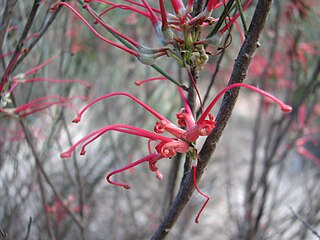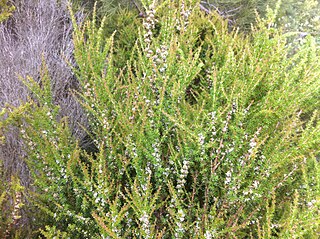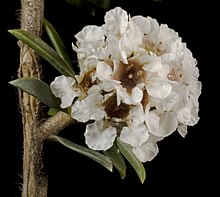
Agonis is a genus in the plant family Myrtaceae. All are endemic to Western Australia, growing near the coast in the south west.

Agonis flexuosa is a species of tree that grows in the south west of Western Australia. It is easily the most common of the Agonis species, and is one of the most recognisable trees of Western Australia, being commonly grown in parks and on road verges in Perth.

Taxandria juniperina commonly known as wattie, native cedar, Warren River cedar or juniper myrtle is a species of tree that grows in the south west corner of Western Australia. This plant was previously classified as Agonis juniperina but is now part of the genus Taxandria. The Noongar peoples know the tree as watti.

Taxandria is a group of plants in the family Myrtaceae described as a genus in 2007. The entire genus is endemic to Western Australia, growing near the coast in the South West corner of the State.

Grevillea sarissa, the wheel grevillea, is a shrub which is native to South Australia and Western Australia. It grows to between 0.6 and 3.5 metres in height and produces yellow, red or pink flowers between August and December in its native range.

Taxandria marginata is a species of shrub that grows in the south west corner of Western Australia. This plant was previously classified as Agonis marginata but was reclassified by Wheeler and Marchant into the new genus Taxandria in a 2007 revision.

Paragonis grandiflora is a plant species, endemic to the Southwest of Western Australia.
Verticordia helmsii is a flowering plant in the myrtle family, Myrtaceae and is endemic to the south-west of Western Australia. It is a shrub with most of its leaves clustered on short side branches and with small groups of scented creamish-white flowers in small groups along the branches.

Darwinia apiculata, commonly known as the scarp darwinia, is a plant in the myrtle family Myrtaceae and is endemic to a small area in Western Australia. It is a rounded, densely branched, small shrub with thin red branches and scattered small leaves. The flowers are arranged in small groups on the ends of the branches, their most obvious feature being long, red, pointed bracts surrounding each flower and a longer red style with scattered hairs near its tip.

Darwinia wittwerorum, commonly known as Wittwer's darwinia, is a plant in the myrtle family Myrtaceae and is endemic to a small area in Western Australia. An erect, spindly shrub with fine leaves and hanging groups of flowers surrounded by leaf-like bracts, it is one of the darwinias known as mountain bells.
Agonis baxteri is a shrub that is native to Western Australia.
Taxandria angustifolia is a species of tree that grows on the south coast of Western Australia. This plant was previously classified as Agonis angustifolia but is now part of the Taxandria genus.

Taxandria parviceps, commonly known as tea tree, is a shrub species that grows on the south west coast of Western Australia. This plant was previously classified as Agonis parviceps but is now part of the Taxandria genus.

Taxandria spathulata is a shrub species that grows along the southern coast of Western Australia. This plant was previously classified as Agonis spathulata but is now part of the Taxandria genus.

Taxandria linearifolia, also known as the swamp peppermint or the coarse teatree, is a small tree or shrub species that grows along south west coastal areas of Western Australia. This plant was previously classified as Agonis linearifolia but is now part of the Taxandria genus.
Taxandria floribunda is a small tree or shrub species that is endemic to an area in southern Western Australia. This plant was previously classified as Agonis floribunda but is now part of the Taxandria genus.
Taxandria callistachys is a shrub species that is endemic to an area in southern Western Australia.
Taxandria fragrans is a shrub species that is endemic to an area in south western Western Australia.
Enekbatus clavifolius is a shrub endemic to Western Australia.
Enekbatus stowardii is a shrub endemic to Western Australia.











